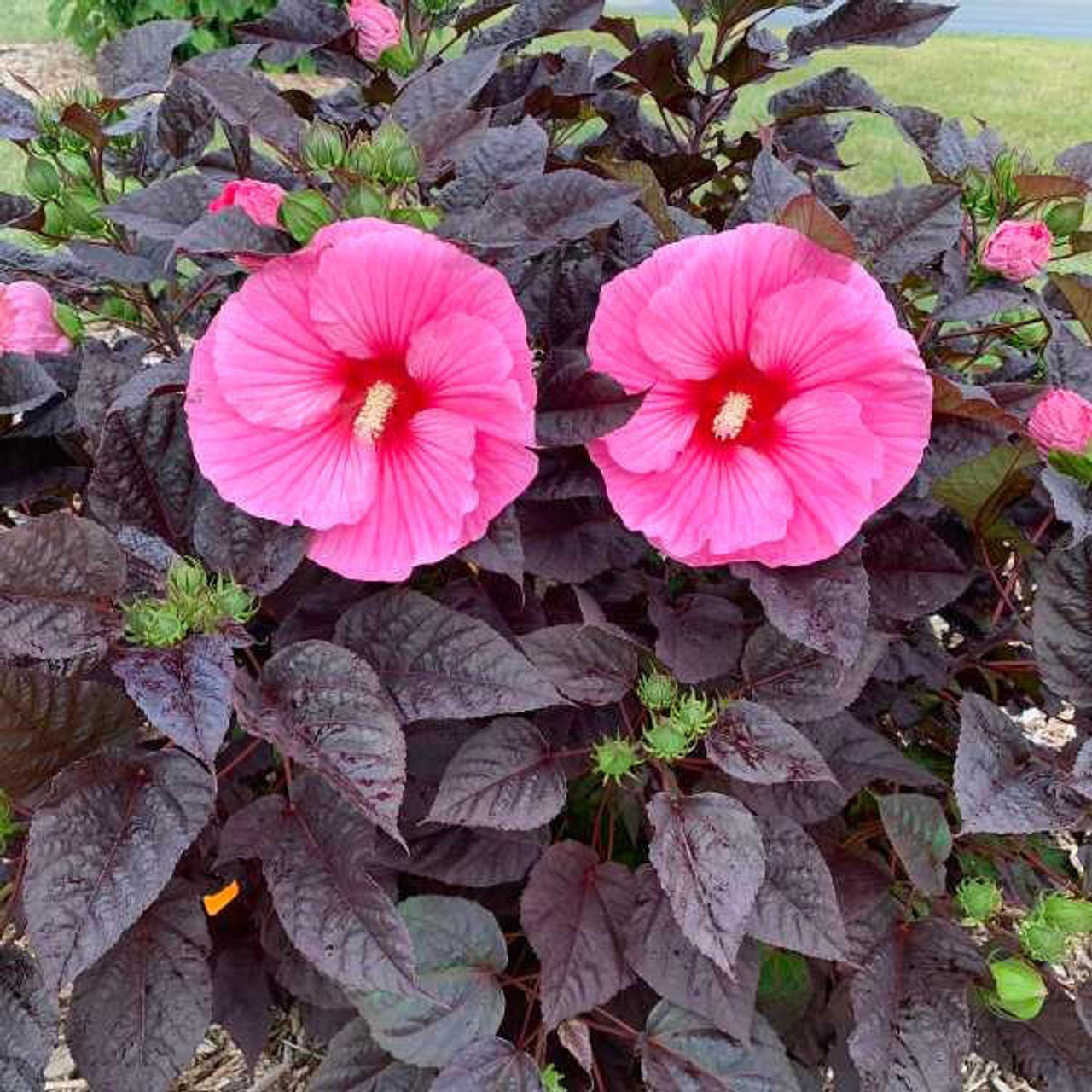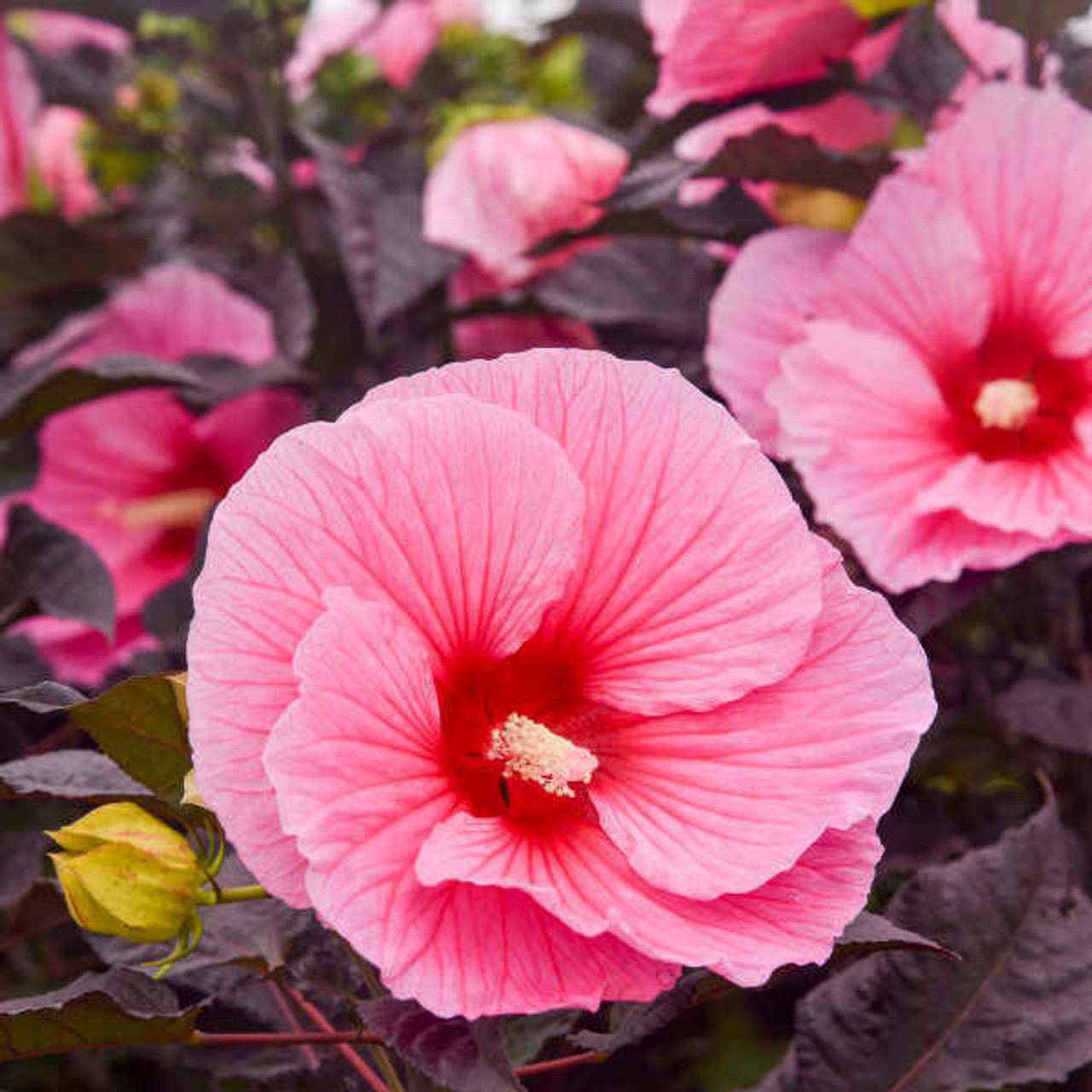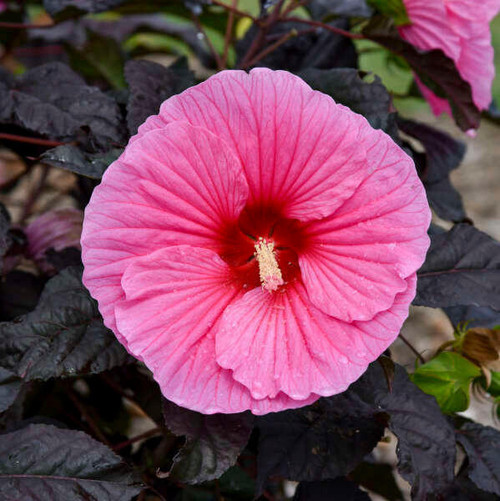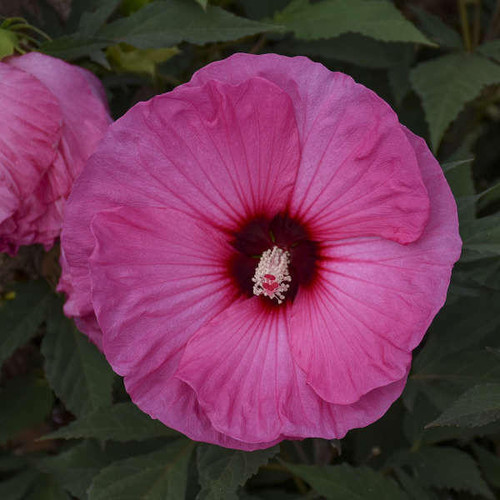Product Description
Hibiscus 'Edge of Night' PP34359 CPBRAF (4) 1-gallons
SUMMERIFIC® Collection
Common Name: Rose Mallow
One of our most hotly anticipated additions to the SUMMERIFIC® lineup in recent years! At only 3-3½' tall, this is our most compact Hibiscus to date. 7-8" bubblegum pink flowers have overlapping petals and darker pink veining for a dramatic 3D effect. Jet black foliage is the darkest we've seen on a Hibiscus and contrasts nicely with the green flower calyxes and red veining and petioles. Compared to 'Evening Rose', this has darker foliage, a more compact habit, and brighter pink flowers. Best color and performance will be in full sun.
These North American native plants bring massive, tropical-looking flowers all the way to zone 4. Although later to emerge than most perennials in spring, these are fast growing plants capable of adding an inch of new growth a day. Excellent at brightening up end of season gardens.
Hibiscus love the sun and need moist, well-drained soil. Keeping these plants watered will result in larger flowers and lush foliage. Deadheading will improve the appearance of the plant. It is best to plant Hibiscus in the garden before the heat of the summer arrives and should be heavily mulched the first winter. In spring, cut back any remaining stems before new growth appears. A strong pair of loppers or a saw will be necessary to cut this plant back. Be advised that Hibiscus is always one of the last perennials to emerge in spring. Its vigorous growth rate more than makes up for this late start, however. Japanese beetles find these plants especially delicious.
Farwest People's Choice Award of Merit -- 2022
Height: 3.0-3.5 Feet
Spread: 4.0-4.5 Feet
Hardiness Zones: 4,5,6,7,8,9
Flower Color: Pink shades
Foliage Color: Near-black shades
Full Sun to Part Shade
Average to Consistent Water Needs
Poor to Fertile Soil Quality
Bloomtime: Midsummer - Late Summer
Attracts Butterflies
Bee Friendly
Deer Resistant
Growth Rate: Rapid
Attractive Foliage, Bog Plant, Border Plant, Specimen, Focal Point
Hibiscus 'Edge of Night' is a showstopping hardy hibiscus that offers a captivating contrast between its dramatic, jet-black foliage and vibrant, bubblegum-pink flowers. This striking perennial features extremely large, 7-8 inch blooms with overlapping petals and darker pink veining, creating a stunning 3D effect. The flowers emerge from abundant buds that cover the plant all the way up the stems, ensuring a long blooming period from midsummer to early fall. The unique, dark foliage provides a captivating backdrop for the bright pink flowers and adds depth and interest to the garden even when not in bloom. 'Edge of Night' forms a compact, bushy mound, making it an excellent choice for borders or containers.
Details:
- Mature Size: 3-3.5 feet tall, 4-5 feet wide
- Flower Size: 7-8 inches across
- Flower Color: Bubblegum pink with darker pink veining
- Bloom Time: Midsummer to early fall
- Growth Habit: Compact, bushy, mounding
- Sunlight: Full Sun to Partial Shade (at least 6 hours of direct sunlight for best flowering)
- Soil: Well-drained, slightly acidic to neutral (pH 6.0-7.0)
- Hardiness Zones: 4-9
Planting and Care:
- Planting: Plant in spring after the last frost has passed. Choose a location with full sun to partial shade, ensuring at least 6 hours of direct sunlight per day for optimal flowering. Amend the soil with compost or other organic matter to improve drainage and fertility. Dig a hole slightly larger than the root ball and plant at the same depth as the container. Space plants about 3-4 feet apart.
- Watering: Water regularly, especially during dry periods, to keep the soil consistently moist but not waterlogged.
- Fertilizing: Apply a balanced, slow-release fertilizer in early spring and again in mid-summer to promote vigorous growth and flowering.
- Mulching: Apply a 2-3 inch layer of mulch around the base of the plant to help retain moisture, suppress weeds, and protect the roots in winter.
- Pruning: Deadhead spent flowers to encourage continuous blooming and maintain a tidy appearance. In late winter or early spring, before new growth emerges, prune back any dead or damaged stems to promote bushier growth.
- Pest and Disease Control: Monitor for common hibiscus pests such as aphids, Japanese beetles, and spider mites, and take appropriate measures if necessary. Ensure good air circulation and avoid overhead watering to prevent fungal diseases.
Special Considerations:
- Hibiscus 'Edge of Night' is a dramatic and eye-catching addition to any sunny garden.
- Its unique, jet-black foliage and vibrant pink flowers create a captivating contrast.
- It attracts pollinators like bees and butterflies.
- It is generally deer-resistant.
(4) 1-gallon containers ready to plant, plants may be trimmed for shipping,
Other Details
The most important part of the plant is its root system. Healthy roots are the foundation of a healthy, vibrant plant. The type of plug container used is based on the specific needs of the plants. Perennials offered as bare root traditionally perform better when planted as bare root.Planted in a specialized mix, potted plants have well established root systems. Top growth stage will vary depending on the current life cycle and time of year when shipped. In Winter and early Spring dormant plants may be shipped. Dormant plants may be planted right away, even before the last frost date.
Most bare root varieties are field grown for at least one season, though Hemerocallis and Hosta are grown for two seasons. The bulk of the soil is removed during the harvesting process and the tops of most varieties are trimmed back to the crown. They are graded, packed in shredded aspen or sphagnum moss and stored in freezers until ready to be shipped.
See our Container Sizes and Bare Root Perennials pages for more information.
Plant information and care is provided in the Overview section, Plant Genus Page and general information is provided in the Planting Care & Guides. Additional questions can be asked on each Plant page.
Plant Spacing: Using the maximum mature spread or width of a plant to guide spacing, ensures space to grow to full size. To fill an area sooner, plant them closer together. Just remember, future thinning or transplanting may be needed.
Water: Keep a close eye on newly planted perennials, especially throughout the first growing year. Most early plant loss is due to too much or too little water!



















